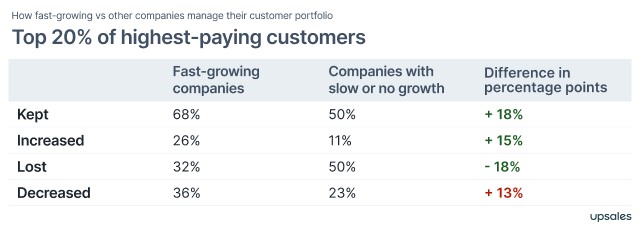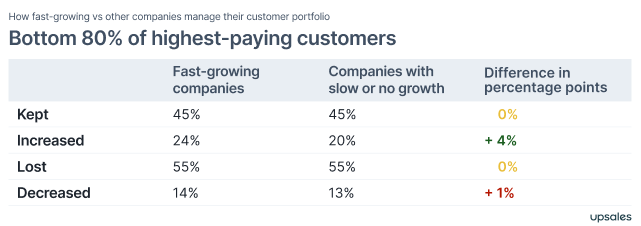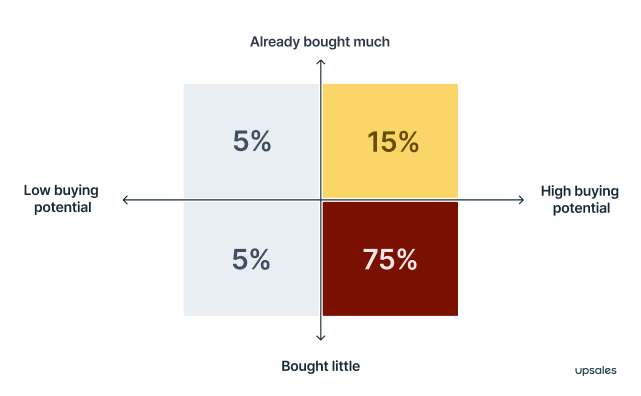Salespeople aren't very good at prioritising their time.
That's not because they're stupid.
It's because they're stressed.
The best thing we can do as leaders is to trample the path and help them not to go astray.
Why the 'default' makes you miss business potential
Most companies give every customer and prospect a dedicated account manager. It's the default, and I'm surprised how few reflect on its consequences.
Distributing time equally will distract your sales team. You're also risking missing out on serious business potential.
Fast-growing companies enforce the Pareto principle
The well-known Pareto principle says that 80% of consequences come from 20% of the causes. It shows the unequal relationship between inputs and outputs. Humbly reminding us, we can't expect the same results from all efforts.
So, we decided to put the concept up for a test.
And the result?
We studied 2000 companies and separated companies growing 20% or more from companies with slow or no growth.
It turns out fast-growing companies take better care of their 20% highest-paying customers. Essentially, they keep more of these clients, expand them, and lose fewer than companies with slow or no growth.


Our data clearly shows that fast-growing companies do enforce the Pareto principle in their work. The focused efforts on business-critical accounts help them generate better financial results.
The well-thought-out way of prioritising work
At Upsales, we work with this prioritisation matrix.

It's a great mindset to incorporate into the team. The matrix helps them identify where their time will have a genuine business impact.
How to identify high-value customers
To identify a high-value customer, you must first quantify the value you deliver.
You can do this in many different ways. An efficient one is to put an alternative price tag on your solution. What would it cost the customer to solve their problem without your offering?
Customers who can't find another solution, or where the alternative is expensive, are likely to keep wanting what you're offering (even if prices increase).
These are the customers you'd like to go after.
Their use case is usually spot-on, and their price sensitivity is low. You can also find many upsell possibilities here, especially if their current spending is low compared to revenue.
How to identify low-value customers
So, how can we understand which customers we shouldn't pursue?
In general, they're smaller and less willing to pay. We often have a hunch about who these customers are. They tend to fill up the calendar and inbox with questions. Once it's time to discuss further collaboration, however, they're nowhere to be found.
Find a win-win for both parties
A while back, we had many smaller customers. They were happy. They paid their licenses, but somewhere we knew they wouldn't increase their spending.
Our team spent a lot of time on them. The customers got irritated when they reached out, and expansions never happened.
In other words = we had some organisational work to do.
Our account managers were stuck in day-to-day details at the time, and the team set-up wasn't great.
So, we reorganised and made huge investments in the support team.
Today, customers who don't make the 'high priority" quadrants communicate with our support. And the best part? We're confident they're getting the best experience possible. They don’t get called too often, and all their questions are solved thanks to the quality of our support team.
Always have a plan for less prioritised accounts
The moral of the story? We'll always have customers who are happy where they are. The sales team shouldn't spend their time on these, but it's important they have somewhere else to go.
Simply removing them from your prioritisation list can cause badwill. Make sure to delegate them to another part of the organisation first.
An unconventional (but very effective) way to increase the bottom line
Large customers often end up in the high-priority quadrants. These companies are typically more willing to pay to solve a problem than small customers.
Yet, many of us bill them as they're no different.
Most companies think too small
If you're charging a €10M company the same as a €100M company, you've failed with your packaging.
It's signalling that you need to become better at segmenting customers.
Doesn’t it make sense that a customer should pay ten times more if their revenue is ten times higher?
Figure out how you can double a customer's spending
My best advice for developing a solid price model is to involve your best customers in the process.
What do your 20% highest-paying customers think of your offering?
If you're aiming to double their spending – call a customer and ask them what you need to deliver to make them do just that.
Then focus on solving their problems.
Only a fool would be the victim of poor time management
Everything from product development to pricing becomes easier when you know your most important accounts.
Spending 80% of the time on 20% of (your best) customers is a brilliant shortcut to crushing targets. For us, prioritising wiser has been one of the most impactful changes for revenue growth.
I'm confident you'll also close more high-value deals by prioritising like this.
/ Daniel Wikberg
CEO & Founder of Upsales









